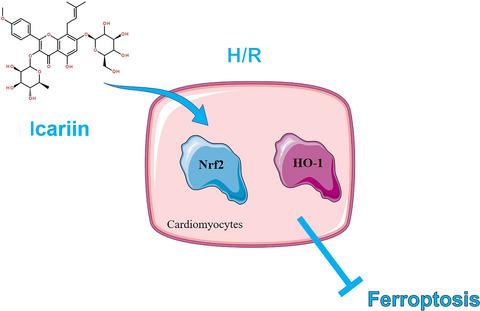当前位置:
X-MOL 学术
›
FEBS Open Bio
›
论文详情
Our official English website, www.x-mol.net, welcomes your feedback! (Note: you will need to create a separate account there.)
Icariin inhibits hypoxia/reoxygenation-induced ferroptosis of cardiomyocytes via regulation of the Nrf2/HO-1 signaling pathway
FEBS Open Bio ( IF 2.6 ) Pub Date : 2021-08-18 , DOI: 10.1002/2211-5463.13276 Xiu-Juan Liu 1 , Yan-Fei Lv 2 , Wen-Zhu Cui 3 , Yan Li 1 , Yang Liu 1 , Yi-Tao Xue 1 , Feng Dong 1
FEBS Open Bio ( IF 2.6 ) Pub Date : 2021-08-18 , DOI: 10.1002/2211-5463.13276 Xiu-Juan Liu 1 , Yan-Fei Lv 2 , Wen-Zhu Cui 3 , Yan Li 1 , Yang Liu 1 , Yi-Tao Xue 1 , Feng Dong 1
Affiliation

|
Myocardial infarction (MI) is caused by the formation of plaques in the arterial walls, leading to a decrease of blood flow to the heart and myocardium injury as a result of hypoxia. Ferroptosis is a crucial event in myocardial injury, and icariin (ICA) exerts protective effects against myocardial injury. Here, we investigated the protective mechanism of ICA in hypoxia/reoxygenation (H/R)-induced ferroptosis of cardiomyocytes. H9C2 cells were subjected to H/R induction. The content of lactate dehydrogenase and the levels of oxidative stress and intracellular ferrous ion Fe2+ were measured. The levels of ferroptosis markers (ACSL4 and GPX4) were detected. H/R-induced H9C2 cells were cultured with ICA in the presence or absence of ferroptosis inducer (erastin). Znpp (an HO-1 inhibitor) was added to ICA-treated H/R cells to verify the role of the Nrf2/HO-1 pathway. H/R-induced H9C2 cells showed reduced viability, enhanced oxidative stress and lactate dehydrogenase content, increased levels of Fe2+ and ACSL4, and decreased levels of GPX4. ICA inhibited H/R-induced ferroptosis and oxidative stress in cardiomyocytes. Erastin treatment reversed the inhibitory effect of ICA on ferroptosis in H/R cells. The expression of Nrf2 and HO-1 in H/R-induced H9C2 cells was reduced, whereas ICA treatment reversed this trend. Inhibition of the Nrf2/HO-1 pathway reversed the protective effect of ICA on H/R-induced ferroptosis. Collectively, our results suggest that ICA attenuates H/R-induced ferroptosis of cardiomyocytes by activating the Nrf2/HO-1 signaling pathway.
中文翻译:

淫羊藿苷通过调节 Nrf2/HO-1 信号通路抑制缺氧/复氧诱导的心肌细胞铁死亡
心肌梗塞 (MI) 是由动脉壁上形成斑块引起的,由于缺氧导致流向心脏的血流量减少和心肌损伤。铁死亡是心肌损伤的关键事件,淫羊藿苷(ICA)对心肌损伤具有保护作用。在这里,我们研究了 ICA 在缺氧/复氧 (H/R) 诱导的心肌细胞铁死亡中的保护机制。对 H9C2 细胞进行 H/R 诱导。乳酸脱氢酶含量及氧化应激水平和细胞内亚铁离子Fe 2+水平被测量了。检测铁死亡标志物(ACSL4和GPX4)的水平。在存在或不存在铁死亡诱导剂(erastin)的情况下,用 ICA 培养 H/R 诱导的 H9C2 细胞。将 Znpp(一种 HO-1 抑制剂)添加到 ICA 处理的 H/R 细胞中以验证 Nrf2/HO-1 通路的作用。H/R 诱导的 H9C2 细胞活力降低,氧化应激和乳酸脱氢酶含量增加,Fe 2+水平升高和 ACSL4,并降低了 GPX4 的水平。ICA 抑制 H/R 诱导的心肌细胞铁死亡和氧化应激。Erastin 治疗逆转了 ICA 对 H/R 细胞铁死亡的抑制作用。H/R 诱导的 H9C2 细胞中 Nrf2 和 HO-1 的表达降低,而 ICA 处理逆转了这一趋势。Nrf2/HO-1 通路的抑制逆转了 ICA 对 H/R 诱导的铁死亡的保护作用。总的来说,我们的研究结果表明,ICA 通过激活 Nrf2/HO-1 信号通路来减轻 H/R 诱导的心肌细胞铁死亡。
更新日期:2021-08-18
中文翻译:

淫羊藿苷通过调节 Nrf2/HO-1 信号通路抑制缺氧/复氧诱导的心肌细胞铁死亡
心肌梗塞 (MI) 是由动脉壁上形成斑块引起的,由于缺氧导致流向心脏的血流量减少和心肌损伤。铁死亡是心肌损伤的关键事件,淫羊藿苷(ICA)对心肌损伤具有保护作用。在这里,我们研究了 ICA 在缺氧/复氧 (H/R) 诱导的心肌细胞铁死亡中的保护机制。对 H9C2 细胞进行 H/R 诱导。乳酸脱氢酶含量及氧化应激水平和细胞内亚铁离子Fe 2+水平被测量了。检测铁死亡标志物(ACSL4和GPX4)的水平。在存在或不存在铁死亡诱导剂(erastin)的情况下,用 ICA 培养 H/R 诱导的 H9C2 细胞。将 Znpp(一种 HO-1 抑制剂)添加到 ICA 处理的 H/R 细胞中以验证 Nrf2/HO-1 通路的作用。H/R 诱导的 H9C2 细胞活力降低,氧化应激和乳酸脱氢酶含量增加,Fe 2+水平升高和 ACSL4,并降低了 GPX4 的水平。ICA 抑制 H/R 诱导的心肌细胞铁死亡和氧化应激。Erastin 治疗逆转了 ICA 对 H/R 细胞铁死亡的抑制作用。H/R 诱导的 H9C2 细胞中 Nrf2 和 HO-1 的表达降低,而 ICA 处理逆转了这一趋势。Nrf2/HO-1 通路的抑制逆转了 ICA 对 H/R 诱导的铁死亡的保护作用。总的来说,我们的研究结果表明,ICA 通过激活 Nrf2/HO-1 信号通路来减轻 H/R 诱导的心肌细胞铁死亡。



























 京公网安备 11010802027423号
京公网安备 11010802027423号